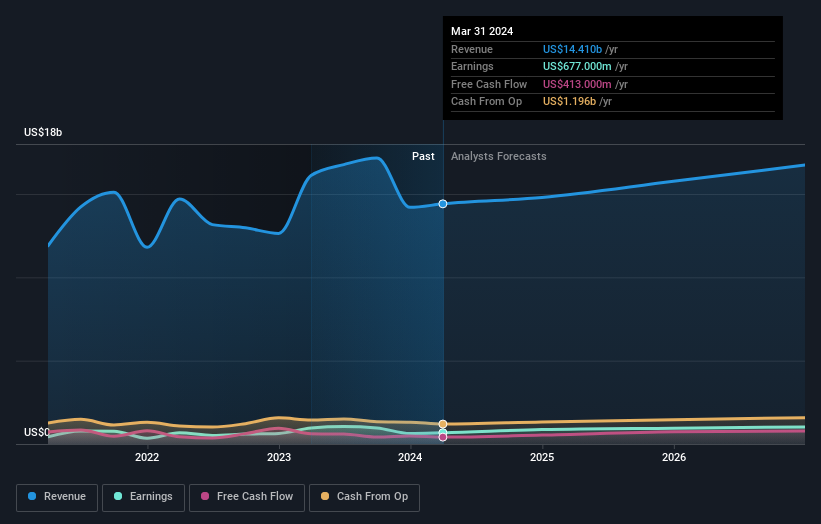BorgWarner Inc. (NYSE:BWA) just released its latest first-quarter results and things are looking bullish. Results were good overall, with revenues beating analyst predictions by 2.3% to hit US$3.6b. Statutory earnings per share (EPS) came in at US$0.90, some 5.3% above whatthe analysts had expected. The analysts typically update their forecasts at each earnings report, and we can judge from their estimates whether their view of the company has changed or if there are any new concerns to be aware of. Readers will be glad to know we’ve aggregated the latest statutory forecasts to see whether the analysts have changed their mind on BorgWarner after the latest results.
See our latest analysis for BorgWarner
Taking into account the latest results, the consensus forecast from BorgWarner’s 18 analysts is for revenues of US$14.8b in 2024. This reflects a satisfactory 2.6% improvement in revenue compared to the last 12 months. Per-share earnings are expected to leap 30% to US$3.81. In the lead-up to this report, the analysts had been modelling revenues of US$14.8b and earnings per share (EPS) of US$3.75 in 2024. So it’s pretty clear that, although the analysts have updated their estimates, there’s been no major change in expectations for the business following the latest results.
There were no changes to revenue or earnings estimates or the price target of US$40.39, suggesting that the company has met expectations in its recent result. It could also be instructive to look at the range of analyst estimates, to evaluate how different the outlier opinions are from the mean. There are some variant perceptions on BorgWarner, with the most bullish analyst valuing it at US$52.00 and the most bearish at US$33.00 per share. These price targets show that analysts do have some differing views on the business, but the estimates do not vary enough to suggest to us that some are betting on wild success or utter failure.
These estimates are interesting, but it can be useful to paint some more broad strokes when seeing how forecasts compare, both to the BorgWarner’s past performance and to peers in the same industry. It’s pretty clear that there is an expectation that BorgWarner’s revenue growth will slow down substantially, with revenues to the end of 2024 expected to display 3.5% growth on an annualised basis. This is compared to a historical growth rate of 11% over the past five years. By way of comparison, the other companies in this industry with analyst coverage are forecast to grow their revenue at 11% per year. Factoring in the forecast slowdown in growth, it seems obvious that BorgWarner is also expected to grow slower than other industry participants.
The Bottom Line
The most obvious conclusion is that there’s been no major change in the business’ prospects in recent times, with the analysts holding their earnings forecasts steady, in line with previous estimates. On the plus side, there were no major changes to revenue estimates; although forecasts imply they will perform worse than the wider industry. The consensus price target held steady at US$40.39, with the latest estimates not enough to have an impact on their price targets.
Keeping that in mind, we still think that the longer term trajectory of the business is much more important for investors to consider. We have forecasts for BorgWarner going out to 2026, and you can see them free on our platform here.
Before you take the next step you should know about the 2 warning signs for BorgWarner that we have uncovered.
Have feedback on this article? Concerned about the content? Get in touch with us directly. Alternatively, email editorial-team (at) simplywallst.com.
This article by Simply Wall St is general in nature. We provide commentary based on historical data and analyst forecasts only using an unbiased methodology and our articles are not intended to be financial advice. It does not constitute a recommendation to buy or sell any stock, and does not take account of your objectives, or your financial situation. We aim to bring you long-term focused analysis driven by fundamental data. Note that our analysis may not factor in the latest price-sensitive company announcements or qualitative material. Simply Wall St has no position in any stocks mentioned.
